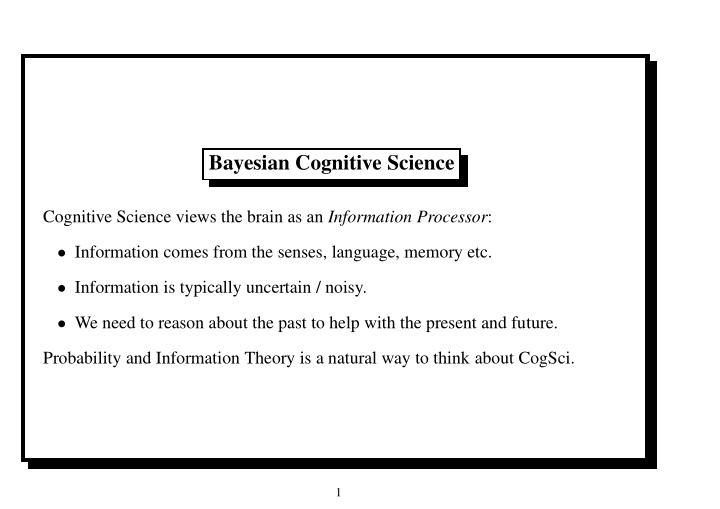



Bayesian Cognitive Science Cognitive Science views the brain as an Information Processor : • Information comes from the senses, language, memory etc. • Information is typically uncertain / noisy. • We need to reason about the past to help with the present and future. Probability and Information Theory is a natural way to think about CogSci. 1
Playing Tennis Suppose you are playing tennis: • You know how quickly you can move. • You have an idea how your partner will server. • How can you anticipate the best action to take? 2
Playing Tennis We can think of the world as being a state : • A state encodes where the ball will bounce. We can connect to the world using sensory input : • Sensory input means watching the opponent. 3
Playing Tennis Putting the two together: P ( state | sensory input ) = P ( sensory input | state ) P ( state ) P ( sensory input ) This allows us to combine together what we see with that we believe. Experimental results suggest that people learn the prior and combine with sensory evidence is a similar manner. 4
Eating Puffer Fish Puffer fish is a delicacy. But (WikiPedia): (contains) a powerful neurotoxin that can cause death in nearly 60% of the humans that ingest it. A human only has to ingest a few milligrams of the toxin for a fatal reaction to occur. Once consumed the toxin blocks the sodium channels in the nervous tissues, ultimately paralyzing the muscle tissue. 5
Eating Puffer Fish People like eating Puffer Fish, yet have to consider the possibility of being poisoned. • Can we reason about the cost of eating Puffer Fish against the yummy taste? • We wish to select some action which has the lowest average cost over all possible states. • Decision Theory allows us to reason about taking optimal actions. 6
Eating Puffer Fish Decision theory connects actions with probabilities: • L ( X , Y ) is a loss function . • A loss function characterises the cost of taking action X in state Y . – L(eat, poisoned): the cost of eating bad fish. – L(eat, safe): the cost of eating good fish. 7
Eating Puffer Fish We need to consider all possible states: E ( action ) = ∑ L ( action , state ) P ( state | action ) state • Suppose we believe that the cost of eating bad fish is 5000 • And believe that the cost of eating safe fish is 0. • P ( poisoned | eat ) = 1 10 , 000 Should we eat the fish? 8
Eating Puffer Fish The expected loss of eating fish is then: E ( eat ) = L ( eat, poisoned ) P ( poisoned | eat )+ L ( eat, safe ) P ( safe | eat ) = − 0 . 4999 • If we do nothing, then the loss is zero. We should therefore eat the fish. 9
Decision Theory • Decision theory allows us to reason about the relationship between perceived costs and uncertainty. • DT has been applied to neural processing. 10
Occam’s Razor One theory of human learning is that we try to find simple descriptions: • The World rests on a tortoise, which swims in an ocean . . . • The World is a rock in space. Occam’s Razor : All things being equal, the simplest solution tends to be the best one. How can we formalise simplicity? 11
Occam’s Razor Information Theory considers compressing items: • If an item X occurs with probability P ( X ) , then an optimal code will use l ( x ) = − log P ( X ) units to represent it. • l ( x ) is the description length of x . – Suppose the letter e has P ( e ) = 1 / 5 and z has P ( z ) = 1 / 100. – l ( e ) = 1.6 units, l ( z ) = 4.6 units • The complexity of a theory is then equivalent to the description length of that theory. 12
Occam’s Razor Highly likely theories will receive short description lengths. • An empty theory will have a minimally short description! • We also need to consider how well the theory accounts for the data (. . . All things being equal ). • The likelihood is a natural way to talk about the data in terms of a theory: P ( D | M ) . • l ( P ( D | M )) gives us the length of the data encoded in the model. High likelihoods compactly describe the data. 13
Occam’s Razor Putting it together: • Select a compact model, which describes the data simply: L ( M )+ L ( D | M ) • This shows the connection between Bayes Theorem and simplicity. • Much CogSci can be seen in terms of simplicity: Process Data Code Language learning Linguistic input Grammars Low-level preception Sensory input Filters in early vision Ants Paths to food tactile contact between ants 14
Summary Probability is a rich language for CogSci: • Bayes allows us to talk about combining together existing knowledge with our current state-of-affairs. • Decision theory allows us to reason about subjective costs and uncertainty. • Information Theory lets us talk about simplicity in a formal manner. Final comment: do we actually think using probabilities, or is it just a metaphor? 15
Recommend
More recommend